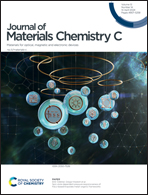Improving the hole mobility of conjugated semiconducting polymer films by fast backbone aggregation during the film formation process†
Abstract
How to increase the carrier mobility of donor–acceptor (D–A) conjugated polymer semiconductor films has always been a hot topic in the field of organic electronics. The aggregations via π–π interactions of conjugated polymer films serve as an effective approach for improving the charge-transport property. However, the polymer film formation process was extremely complex, so it remains challenging to regulate the morphologies of the film exactly by controlling the solution-state aggregation and film formation kinetics. Herein, we proposed the strategy to prepare films that contained large aggregations with tight π–π stacking via fast aggregation between backbones during film formation by adjusting the solubility difference Ra (b–s) of the backbone and side chain in the solvent. For this purpose, three solvents with different Ra (b–s) (chloroform, benzene, and cyclohexane) were chosen. For the benzene solvent, the interchain aggregation in the solution was the weakest among the three solvents (cyclohexane > chloroform > benzene). However, the aggregation speed (k) of benzene is the fastest (benzene > chloroform > cyclohexane) during solvent evaporation. Thus, the solid film obtained from the benzene solvent has larger aggregation and tighter π–π stacking than those of the other two films. Therefore, the mobility of the IDTBT film cast from benzene solution (2.35 cm2 V−1 s−1) is much higher than that of the other two solvents (1.03 cm2 V−1 s−1 for chloroform and 1.79 cm2 V−1 s−1 for cyclohexane). This work offers a novel understanding of the aggregation behavior from solution to film states and reveals how the solubility of the backbone and the side chain of the conjugated polymer in solvent plays an important role in tuning the solution aggregation state.



 Please wait while we load your content...
Please wait while we load your content...